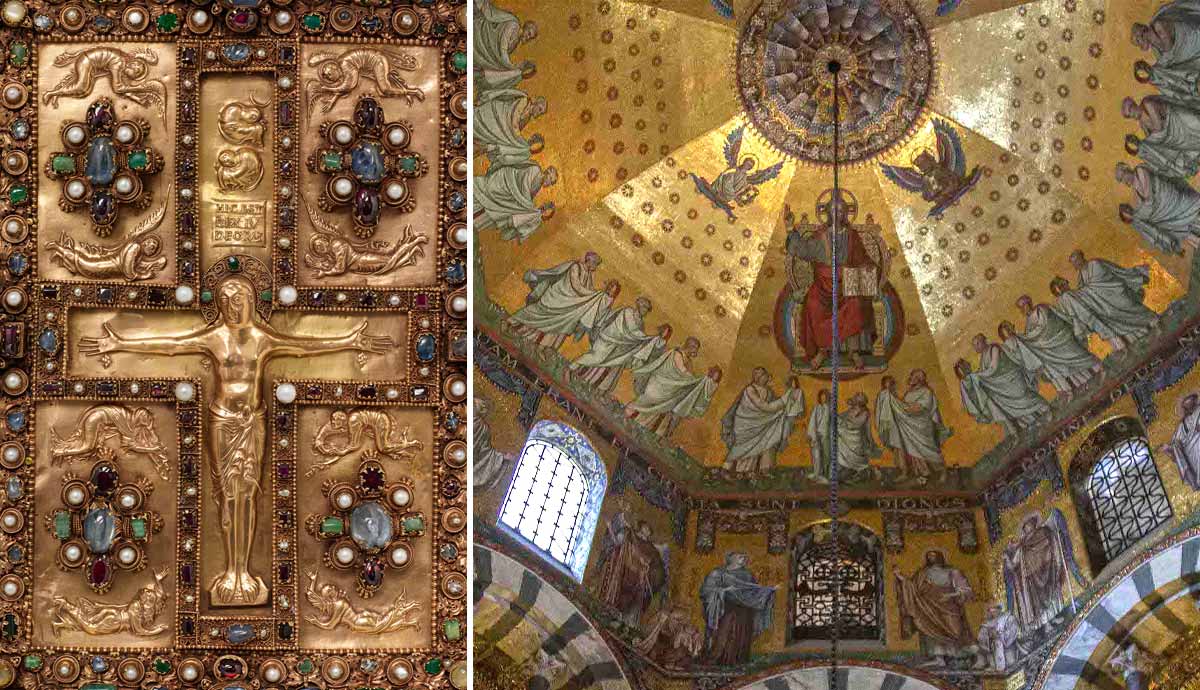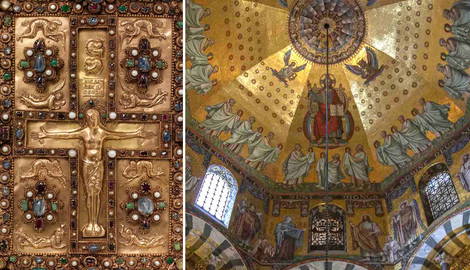
The crowning of Charlemagne as the emperor of the Romans by Pope Leo III on Christmas in 800 marked the entry into a new period for Western Europe. The Frankish kingdom had ascended to the position previously held by the Roman Empire under Constantine the Great. The new Empire was considered the legitimate successor of the Christianized Roman Empire. Like the Roman emperors of faraway Constantinople, Charlemagne was considered the New Constantine or a New David, chosen by divine providence. The relationship with ancient Rome and its revival by Charlemagne was a crucial ideological foundation for the development of Carolingian art. Looking back to the styles of early Christian art, we can see how they influenced Western Europe’s art throughout the Middle Ages.
Carolingian Art & Dynasty

The Carolingian dynasty dominated western Europe politically, culturally, and economically during the 8th and 9th centuries. It carries the name of the almost mythic figure of Charlemagne, or Carolus Magnus in Latin. Like his grandfather and father, Charlemagne was a warrior-king who enlarged the territories of his kingdom in every direction. Throughout his long reign, which began in 768, Charlemagne fought and conquered the Avars, Lombards, Moors, Frisians, and Saxons.
In parallel with the military campaigns, Charlemagne and his court worked on unifying different peoples under the Christian Church. He also emphasized the unity of Church and State and fostered a cultural revival that raised educational standards, reformed the liturgy, and restored the use of Latin among learned men in Western Europe. Charlemagne’s successors, especially Louis the Pious and Charles the Bald, continued the revival, commonly known as the Carolingian Renaissance. The term “Renaissance” is usually replaced with “revival” by modern scholars since the Carolingian dynasty was primarily concerned with forming an educated bureaucracy, not taking inspiration from Greco-Roman culture. The revival of Latin revived, in turn, classical literature and texts, and the teaching of both secular and religious subjects became an educational system that helped the State and Church function.
A considerable part of this cultural revival was the change of attitude of the Franks towards the arts, which fueled the forming of what we today call Carolingian art.
Charlemagne’s Court

Charlemagne might be seen as an unusual leader of a great cultural revival since he could not recognize the letters of the alphabet, could not write, and had almost no knowledge of Latin. Nevertheless, one of his primary duties was to promote and protect the knowledge needed for the function of the Empire. For this purpose, Charlemagne surrounded himself with intellectuals, mostly monks or clerics, in his court in Aachen. Agobard of Lyons, Theodulf of Orleans, Paul the Deacon, Einhard, and Alcuin of York, the closest intellectual to the emperor, were some of his courtiers.
These intellectuals played a crucial role in the development of the Carolingian revival. They had various areas of specialization, but their common goal was to standardize liturgy and revive rhetoric, moral theology, logical argumentation, and poetry. Under the lead of Alcuin, the palace scriptorium of Aachen produced a new script called the Carolingian minuscule, which allowed for clearer written communication. The educational model provided by the court circle spread to other cultural centers, and new schools emerged across the Empire. For Carolingian art and architecture, the cultural revival meant using variegated techniques and motifs.
Carolingian Architecture

The remaining examples of Carolingian architecture show how studiously the Franks tried to emanate their Roman and Late Antique predecessors. The Palatine Chapel at Aachen is the best-preserved building of Carolingian art and an excellent example of the Carolingian revival of classical architecture. The chapel was dedicated to Christ and the Virgin Mary by Pope Leo III in 805. The chapel’s architecture links it to the legacies of ancient Rome and Constantine the Great. The columns and marble stones used in its construction were brought from Rome and Ravenna.
The cloak of Saint Martin, a 4th-century Roman soldier and Christian martyr, was installed in the church at its consecration. The plan of the building imitates the Holy Sepulcher in Jerusalem and San Vitale in Ravenna. The centralized plan surrounding the ambulatory and upper gallery is echoed in the plan of the Palatine chapel. The chapel was used for coronation ceremonies for another 700 years, showcasing the importance of Charlemagne, Carolingian revival, and art.
Another contribution of Carolingian art is the adoption and development of basilica-type churches. Used as church plans from the times of Constantine, Carolingian basilicas were the first to use westworks (monumental, often west-facing entrance section of a church) at their western façade.
Monumental Painting of the Carolingians

The remaining examples of Carolingian art usually point art historians toward book illumination and other crafts; however, monumental painting was also an important characteristic of Carolingian art. With only a few surviving examples, we can only try and reconstruct the gloriousness of what was Carolingian monumental painting. Based on some of the remaining texts of Carolingian scholars, such as Walafrid Strabo, we can assume that all churches were decorated with wall paintings.
Seen only rarely in manuscripts, the Christological, Old Testament, and hagiographical themes were common in church painting. Looking up to his Roman predecessors, Charlemagne had the images of his Spanish war and the Seven Liberal Arts (the basis of the Carolingian revival) painted in his chapel at Aachen. Charlemagne’s imperial tendencies are reflected in the dome of the chapel. The original golden mosaics held the image of Christ enthroned, surrounded by the 24 elders of Revelation, which presented him with the aurum coronarium (golden crowns).
Following Charlemagne, the bishop Theodulf of Orleans had his villa in Germigny-des-Pres decorated with the images of Seven Liberal Arts as frescoes and mosaics. Another of Theodulf’s patronages, the chapel in Germigny-des-Pres, looks up to the Palatine chapel. The chapel’s apse has a unique image of the Arc of Covenant with two cherubs and two angels, with a golden background and purple and blue tones.
Manuscript Illumination

Carolingian art was primarily a literary or book-based phenomenon. Aspirations for authentic texts, biblical, liturgical, or scientific, cannot be separated from their artistic decoration. The magnitude and high level of their preservation give particular importance to Carolingian manuscript illumination.
The figure of Emperor Charlemagne stands as the driving force behind this process. The court library in Aachen had the most extensive collection of books in Western Europe. The library and scriptoria of the Aachen palace profoundly influenced copying and decorating manuscripts throughout the empire. Carolingian scribes put all their efforts into getting as close as they could to the sources they were copying and decorating. In this process, they looked up to their contemporaries from Rome and Byzantium, who were the closest to the sources.
Consequently, the classical representative illumination style was developed in the palace of Aachen. The first preserved manuscript in this style is related to Charlemagne himself. The Godescalc Evangelistary, named after its scribe, recalls the baptism of Charles’s son, Pepin, in the Lateran baptistery. Just as the place of the young prince’s baptism, the motifs of the manuscript recall the Roman imperial tradition. Portraits of the Evangelists, Christ enthroned, and Fountain of Life are full-page illuminations decorated with gold, animal, and floral motifs.
Various Scriptoria and Illumination Centers

The palatine library of Aachen was the most important center of manuscript production and illumination. However, during the 9th century, western cities like Reims and Tours started gaining political and artistic importance. Even provinces produced magnificent works, such as Gundohin’s evangelistary from Othen, Gelon’s sacramentary, and the Carolingian evangelistary from Essen.
A masterpiece hailing from these other centers of Carolingian art is the Utrecht Psalter. Made probably between 820 and 830 in Reims or the convent of Hauvilliers, the psalter was commissioned by Archbishop Ebbo. The book might have been a gift for Charlemagne’s son Louis the Pious, or his newborn son, the later emperor Charles the Bald. The late Roman iconography and the use of Roman capitalis rustica as script show that the illustrations are based on models from the 5th century. Utrecht’s Psalter and the style of Reims’ illumination had a widespread influence. After it was moved to England around 1000, the psalter inspired the Harley Psalter, the Eadwine Psalter, and the Paris Psalter.
Carolingian Goldsmiths

During the Middle Ages, gold symbolized divine light, and objects made from it were a worthy tribute to God. Golden objects usually made for churches, such as altars, ciboria, chests, reliquaries, and book covers, were a cornerstone of Carolingian art. From the period of Charlemagne, only three goldsmithing objects remain: the “talisman” (actually a reliquary) of Charlemagne, an ewer from the treasury of Saint Maurice, and Einhard’s Arch (preserved only as an 18th-century drawing).
After the death of Charlemagne, Carolingian goldsmiths continued their work. One of the Frankish goldsmiths’ most significant works was the Lindau Gospels’ cover. The front cover holds the representation of the Crucifixion. Emulation of ancient art can be seen in the two lower figures mourning Christ’s death, especially their draperies. The crucifix is made of gems and jewels, and its shape recalls the plans of basilica-type buildings. The entire decoration and iconography of the cover symbolizes the Heavenly Jerusalem, as described in the Book of Revelation, and foretells the contents of the book itself.










